Genetically engineered bacterium, and applications thereof in preparation of L-phosphinothricin
A technology of genetically engineered bacteria and enzyme genes, applied in the field of microorganisms, can solve problems such as reducing production costs, and achieve the effects of reducing production costs, increasing content, and prolonging half-life
- Summary
- Abstract
- Description
- Claims
- Application Information
AI Technical Summary
Problems solved by technology
Method used
Image
Examples
Embodiment 1
[0045] Example 1 Increase intracellular PLP concentration and transaminase activity by expressing key enzymes in the PLP synthesis pathway of Escherichia coli by plasmid expression
[0046] For the key gene epd (D-erythrose-4-phosphate dehydrogenase, GenBanK:
[0047] NP_417402.1), dxs (1-deoxyxylulose-5-phosphate synthase, GenBanK: NP_414954.1) and pdxJ (pyridoxine 5'-phosphate synthase, GenBanK: NP_417059.1), for the convenience of investigation For the effect of increasing the intracellular PLP concentration, the gene was cloned into the pCDFDuet-1 plasmid, sequenced correctly and then transformed into Escherichia coli BL21(DE3) to obtain recombinant bacteria Epd, Dxs and PdxJ.
[0048] Use the recombination method to construct the recombinant plasmids of epd, dxs and pdxJ, and the designed primer sequences are as follows (where Promoter is used to obtain the plasmid fragment, with the empty vector pCDFDuet-1 as a template, and other primers are primers for the target gene,...
Embodiment 2
[0070] Example 2 Increase intracellular PLP concentration and transaminase activity by expressing PLP synthetase PdxST via plasmid
[0071] Except for the PLP synthesis pathway of Escherichia coli itself, the pathways of other bacteria to synthesize PLP are DXP-independent pathways. The DXP-independent PLP synthesis pathway only requires the participation of two enzymes (PdxS, pyridoxal biosynthesis lyase and PdxT, glutamine transamidase), and these two enzymes are clustered in the genome as gene clusters. exists in the form of RBS sequence (that is, PdxST, pyridoxal phosphate synthetase, called PLP synthetase), so the gene can be directly amplified and connected to the plasmid.
[0072] The PdxST gene was cloned from the Bacillus subtilis 168 genome (the corresponding gene sequence is shown in SEQ ID NO.1) and connected to the plasmid pCDFDuet-1. The designed primer sequences were:
[0073] PdxST-F (Bgl II): GGA AGATCT GATGGCTCAAACAGGTACTGA
[0074] PdxST-R (Xhol I): CCG ...
Embodiment 3
[0079] Example 3 Effects of different co-expression strategies on intracellular PLP concentration and transaminase activity
[0080] The expression effect of the double-plasmid co-expression strain has a greater relationship with the copy number of the plasmid. The impact of different plasmid combinations on intracellular PLP concentration and transaminase activity is investigated. The specific implementation methods are as follows:
[0081] The gene sequence PdxST of PLP synthetase was connected to the plasmids pCDFDuet-1, pACYCDuet-1, pETDuet-1 and pRSFDuet-1 respectively, and the primer sequences were the same as in Example 2. After the sequence was correct, the recombinant plasmid pdxST-pCDF of PLP synthetase was obtained , PdxST-pACYC, PdxST-pET and PdxST-pRSF;
[0082] In addition, the sequence of transaminase TA1 was connected to plasmids pCDFduet-1 and pETDuet-1 respectively, and the primers used were:
[0083] TA1-Duet-F(Bgl II) GGA AGATCT GATGAACAGCAATAAAGAGTTAATG...
PUM
 Login to View More
Login to View More Abstract
Description
Claims
Application Information
 Login to View More
Login to View More - R&D
- Intellectual Property
- Life Sciences
- Materials
- Tech Scout
- Unparalleled Data Quality
- Higher Quality Content
- 60% Fewer Hallucinations
Browse by: Latest US Patents, China's latest patents, Technical Efficacy Thesaurus, Application Domain, Technology Topic, Popular Technical Reports.
© 2025 PatSnap. All rights reserved.Legal|Privacy policy|Modern Slavery Act Transparency Statement|Sitemap|About US| Contact US: help@patsnap.com



